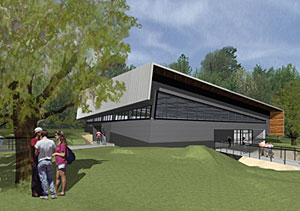Correction appended May 27, 2009
To preserve the prehistoric bones at Waco Mammoth Site, Cotera+Reed Architects has strived to intertwine the firm’s creative vision with the immutable realities of sunlight, Central Texas heat, and the rigors of scientific preservation.
The Austin-based firm has designed an 8,400-square-foot shelter for the dig site that will be open to the public. It will be one of fewer than a dozen buildings in the United States that enclose prehistoric remains in situ—that is, located where they were first discovered. Portions of at least 25 Columbian mammoth skeletons, dating back some 68,000 years, have been identified at the Waco site since the first mammoth bone was spotted there in 1978 protruding from a creek bed.

The site’s development has been a cooperative effort involving Baylor University and the City of Waco. Their initial concept was to build a pole barn to replace the circus-style tent that has covered the skeletons for more than two decades, according to Phillip Reed, AIA, principal at Cotera+Reed. But the architects and the client quickly recognized that a more climate-moderated building would be required: The dramatic swings in Texas temperature, along with humidity levels that can fluctuate 40 percentin a single day, can be damaging to the porous bones over time. “They can cause cracking and flaking both of the fossil material and the soil around it,” explains Anita Benedict, collections manager for Baylor University’s Mayborn Museum Complex.
Instead of a pole barn, the firm got approval to build a metal-clad, one-story building to permanently house and protect the skeletons, along with any additional fossils that may be unearthed in the years ahead. To accommodate visitors, the design includes a suspended catwalk that curves through the shelter, exiting out a side wall.
The shelter incorporates several measures to guard against the elements. For instance, it contains a highly waterproofed, 8-foot-tall attic that sits on the shelter like a lid on a shoebox, extending beyond the building’s walls to provide protective shade. The shelter also is positionedto capture the Texas winds and to use them—along with the help of perforated metal panels—to ventilate the attic, moderating the temperature within.
To protect the bones, no direct sunlight can reach the dirt floor. At the same time, Reed didn’t want visitors to feel like they were walking into a vault. “We tried to humanize what would otherwise be a pretty scientifically derived building,” he says. So he’s provided natural lighting by running clerestory windows along all four walls, which filter out all but 4 percent of ultraviolet light.
Since construction began last fall, protecting the bones has been an overriding priority. Four large wooden boxes were constructed around them, so they couldn’t be harmed by even a falling tool, Reed says. The catwalk will be particularly tricky to construct, as it will be installed piece by piece, ideally while keeping the workers off the floor. The contractor for the project is Waco-based Mazanec Construction.
The dig shelter, which is slated to open this fall, is part of a $3.2-million first phase of the Waco Mammoth Site project. A 1,400-square-foot visitor’s center—also designed by Cotera+Reed— is being constructed abouta quarter of a mile away. A short bridge will lead to the dig shelter, marking the creek where the first mammoth bones were discovered. Reed pictures school-aged children and other young visitors pausing there for a moment, before skipping into the ancient world of mammoths.
Correction: Due to an editor's error, the original headline on this story included the word "Archaeology" rather than "Paleontology." Archaeology is the study of ancient human cultures, not bones.




Post a comment to this article
Report Abusive Comment